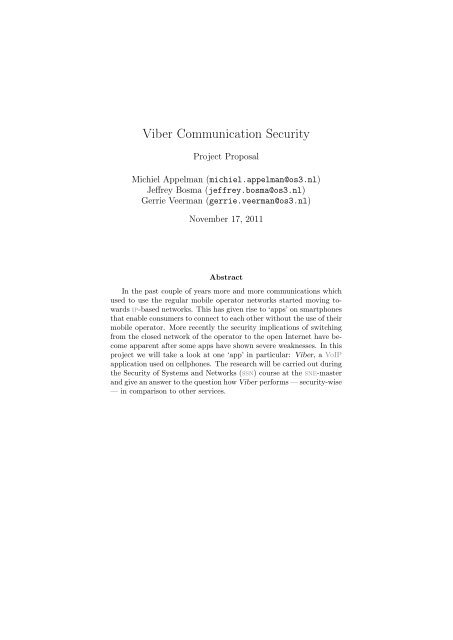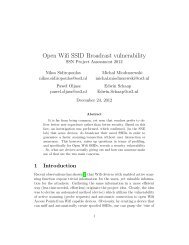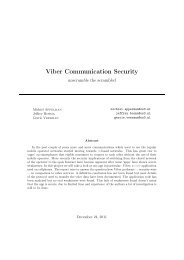Project Proposal – Viber Security
Project Proposal – Viber Security
Project Proposal – Viber Security
Create successful ePaper yourself
Turn your PDF publications into a flip-book with our unique Google optimized e-Paper software.
<strong>Viber</strong> Communication <strong>Security</strong><br />
<strong>Project</strong> <strong>Proposal</strong><br />
Michiel Appelman (michiel.appelman@os3.nl)<br />
Jeffrey Bosma (jeffrey.bosma@os3.nl)<br />
Gerrie Veerman (gerrie.veerman@os3.nl)<br />
November 17, 2011<br />
Abstract<br />
In the past couple of years more and more communications which<br />
used to use the regular mobile operator networks started moving towards<br />
ip-based networks. This has given rise to ‘apps’ on smartphones<br />
that enable consumers to connect to each other without the use of their<br />
mobile operator. More recently the security implications of switching<br />
from the closed network of the operator to the open Internet have become<br />
apparent after some apps have shown severe weaknesses. In this<br />
project we will take a look at one ‘app’ in particular: <strong>Viber</strong>, a VoIP<br />
application used on cellphones. The research will be carried out during<br />
the <strong>Security</strong> of Systems and Networks (ssn) course at the sne-master<br />
and give an answer to the question how <strong>Viber</strong> performs — security-wise<br />
— in comparison to other services.
Contents<br />
1 Introduction 1<br />
1.1 Research Questions . . . . . . . . . . . . . . . . . . . . . . . . 1<br />
2 Research 2<br />
2.1 Test Setup . . . . . . . . . . . . . . . . . . . . . . . . . . . . . 3<br />
2.2 Analysis . . . . . . . . . . . . . . . . . . . . . . . . . . . . . . 3<br />
3 Schedule 4<br />
3.1 Tasks . . . . . . . . . . . . . . . . . . . . . . . . . . . . . . . 4<br />
3.2 Time Schedule . . . . . . . . . . . . . . . . . . . . . . . . . . 4<br />
A Group 6<br />
A.1 Group Members . . . . . . . . . . . . . . . . . . . . . . . . . . 6<br />
A.2 Coördination . . . . . . . . . . . . . . . . . . . . . . . . . . . 6<br />
A.2.1 Repository . . . . . . . . . . . . . . . . . . . . . . . . 6<br />
B Acronyms 7<br />
ii
1 Introduction<br />
Introduction<br />
<strong>Viber</strong> is a communication application for mobile phones. The current version<br />
works on Android and iPhone. You are able to call, send text messages,<br />
photos or your current Global Position System (gps) location. It’s comparable<br />
to other communication apps in this market like WhatsApp and Skype.<br />
Reviews predict this can be a real competitor to Skype, this because of the<br />
simplicity that <strong>Viber</strong> offers. Besides this it is free of charge. <strong>Viber</strong> states to<br />
be ‘freemium’ which means offering free services with one app and having a<br />
paid app with more attributes/possibilities. Since it is a relative new application<br />
we would like to see which ways of security implementations <strong>Viber</strong> has<br />
made. This since privacy/security is an important issue regarding communication.<br />
A main research question can be formulated in addition with some<br />
sub-questions. Within the sub-questions we can look at two sides: Whats<br />
actually stored on the phone? What is actually transmitted through the<br />
wire? On first sight we couldn’t find much information about the security<br />
<strong>Viber</strong> offers. In Chapter 2 some references can be found regarding to this.<br />
1.1 Research Questions<br />
Main research question:<br />
How secure is communication through the <strong>Viber</strong> application in<br />
comparison to other VoIP services?<br />
Sub-questions about information stored locally:<br />
• What information is stored by <strong>Viber</strong>, and in what form?<br />
• How does <strong>Viber</strong> for iPhone differ from the implementation on Android?<br />
• Are <strong>Viber</strong> messages stored encrypted/scrambled? If yes, what kind of<br />
encryption is used? How prone is it to currently known attacks? What<br />
about photos, and transmitted location information?<br />
Sub-questions about data transferred over the wire:<br />
• How are <strong>Viber</strong> messages send, are they encrypted/scrambled?<br />
• Can one modify the content, the recipient address, or the sender address<br />
of a message?<br />
• What other kind of flaws are present in the protocol, and how can they<br />
be improved?<br />
1
2 Research<br />
Research<br />
Virtually no research has been done in the fields <strong>Viber</strong>’s security. An extensive<br />
search on the Internet resulted in only a few vague statements from a<br />
spokesperson of <strong>Viber</strong>. This intrigued us and made us very skeptical because<br />
the amount of information, the openness about security implementation and<br />
the clarity on matters of the spokesperson stating these claims is very dubious<br />
to say the least.<br />
The findings about the security implementations in <strong>Viber</strong>, or there absence,<br />
are quoted below.<br />
Regarding the personal information collected by <strong>Viber</strong>, we found the<br />
following in their privay policy:<br />
We take reasonable precaution to protect Personal Information<br />
from misuse, loss and unauthorized access. Although we cannot<br />
guarantee that Personal Information will not be subject to<br />
unauthorized access, we have physical, electronic, and procedural<br />
safeguards in place to protect Personal Information. Personal<br />
Information is stored on our servers and protected by secured<br />
networks to which access is limited to a few authorized employees<br />
and personnel. However, no method of transmission over the<br />
Internet, or method of electronic storage, is 100% secure. 1<br />
Talmon Marco is an online spokesperson for <strong>Viber</strong> and answered a few<br />
questions asked by consumers. About encryption of messages he replied as<br />
follows:<br />
They were not in the very first version, but they are now. 2<br />
When asked about the encryption of calls:<br />
To be honest, since our code is not open source, we cannot claim<br />
‘encryption’ as it is not open to outside scrutiny. The most we can<br />
say is that ‘it is scrambled’ (and in our opinion the same applies<br />
to anybody who does not have an open source technology).<br />
So, <strong>Viber</strong> messages are scrambled. 3<br />
And:<br />
1 http://viber.com/privacypolicy.html<br />
2 http://www.quora.com/Talmon-Marco-Are-the-messages-sent-between-<strong>Viber</strong>-users-encrypted<br />
3 http://i.tuaw.com/2011/04/01/viber-for-iphone-updated-with-free-text-messaging<br />
2
2.1 Test Setup Research<br />
Like the great majority of major, public VoIP services out there,<br />
we don’t encrypt our calls, but we do transmit them peer-to-peer<br />
(the voice itself never reaches our servers). <strong>Viber</strong> text messages,<br />
however, are encrypted. 4<br />
And even went on to say that none of their competitors do either:<br />
About encryption <strong>–</strong> no, the call is not encrypted. none of the<br />
free VoIP providers today (including Skype) encrypts calls. 5<br />
But as another user noted, Skype had a very nice analysis about their<br />
security in 2005:<br />
Thanks for your response. It’d be nice if you could provide at<br />
least some details of how you’re ‘scrambling’ messages. I for one<br />
would also place a lot of value on some ‘independent’ security<br />
analysis, like Tom Berson’s analysis that Skype commissioned in<br />
2005 6 . I certainly appreciate that you don’t want to open your<br />
code to the public, and that you don’t want to make claims that<br />
you cannot back up without opening that code, but I certainly<br />
hope you take the issue seriously and take any steps you can to<br />
make your product’s security more transparent to users. 7<br />
2.1 Test Setup<br />
Using a Wireless access point we are going to connect to the Internet through<br />
a hub. We connect the hub to a laptop on which we will run WireShark/tcpdump<br />
to collect packets transmitted through the network. There are already<br />
an Android and two iOS phones available for testing <strong>Viber</strong>.<br />
2.2 Analysis<br />
When we find the data stream send out by <strong>Viber</strong> we will try to decrypt/unscramble<br />
it by using basic cryptanalysis tools and techniques. It maybe that<br />
our experience in this field is too limited but we will try to discover as much<br />
as possible about the protocol they use.<br />
4 http://www.androidpolice.com/2011/07/20/viber-for-android-leaves-private-beta-now-available-for-e<br />
5 http://veryrite.com/2010/12/05/viber-makes-free-voip-calls-from-iphone-3g3gs4-ipod-touch-ipad-on-<br />
6 http://www.intelligentzia.ch/inforum/skype_security_evaluation.pdf<br />
7 http://i.tuaw.com/2011/04/01/viber-for-iphone-updated-with-free-text-messaging<br />
3
3 Schedule<br />
3.1 Tasks<br />
We divided the different tasks as follows:<br />
Gerrie Jeffrey Michiel<br />
<strong>Project</strong> <strong>Proposal</strong> � � �<br />
Set-up Lab � �<br />
Research other VoIP Services �<br />
Testing <strong>–</strong> Local Storage �<br />
Testing <strong>–</strong> Message Exchange �<br />
Testing <strong>–</strong> Voice Communication �<br />
Compare Services <strong>–</strong> Skype � �<br />
Compare Services <strong>–</strong> Standard sip � �<br />
Write Report � � �<br />
Presentation � �<br />
3.2 Time Schedule<br />
See page 5.<br />
4<br />
Schedule
SSN Research <strong>Project</strong> Nov 17, 2011<br />
Gantt Chart<br />
Name Begin date<br />
Form a Group 7-11-11 10-11-11<br />
Find a Subject 11-11-11 16-11-11<br />
Make a <strong>Project</strong> <strong>Proposal</strong> 17-11-11 17-11-11<br />
Research common VoIP S… 21-11-11 25-11-11<br />
Compare to <strong>Viber</strong> 7-12-11 9-12-11<br />
Set-up a Test Environment 21-11-11 22-11-11<br />
Test <strong>Viber</strong> in Lab 23-11-11 6-12-11<br />
Document Weaknesses 29-11-11 6-12-11<br />
Write Report 2-12-11 16-12-11<br />
Presentation 19-12-11 19-12-11<br />
2011<br />
Week 45 Week 46 Week 47 Week 48 Week 49 Week 50 Week 51 Wee<br />
3
A Group<br />
A.1 Group Members<br />
Michiel Appelman (michiel.appelman@os3.nl)<br />
Skills: Networking and scripting.<br />
Jeffrey Bosma (jeffrey.bosma@os3.nl)<br />
Skills: Basic Assembly and chip programming skills.<br />
Gerrie Veerman (gerrie.veerman@os3.nl)<br />
Skills: All-round engineer.<br />
A.2 Coördination<br />
Group<br />
We keep contact during the classes we have and also e-mail. Apart from irc<br />
we also started using Facebook for im’ing, which worked surprisingly well.<br />
A.2.1 Repository<br />
Using the Dropbox 8 service we share a common repository of files which we<br />
can all use and also has version control integrated. We divided the L ATEX<br />
source in different files to edit these separately.<br />
8 http://www.dropbox.com<br />
6
B Acronyms<br />
gnu GNU’s Not Unix<br />
im Instant Message<br />
ssn <strong>Security</strong> of Systems and Networks<br />
sne Systems and Network Engineering<br />
ip Internet Protocol<br />
irc Internet Relay Chat<br />
VoIP Voice over ip<br />
sip Session Initiation Protocol<br />
rtp Real Time Protocol<br />
gps Global Position System<br />
7<br />
Acronyms





